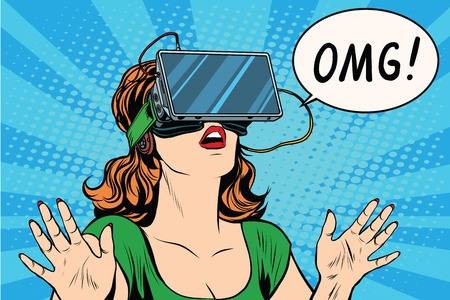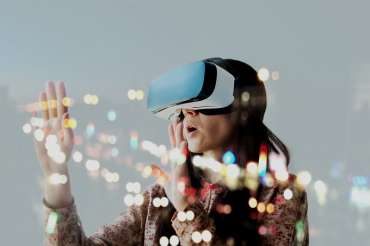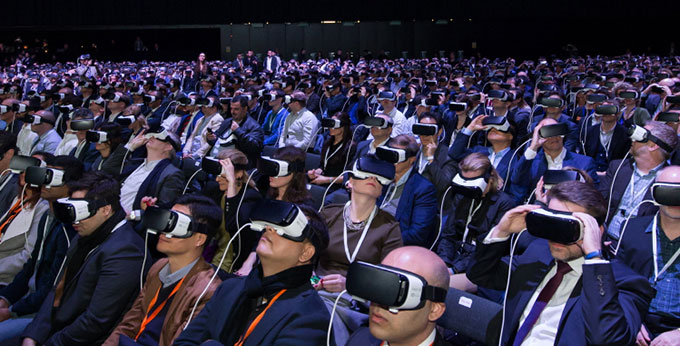
“How can we then say that something exists and at the same time is not real?”
(Brey, 2014)
Virtual enviroments are really powerful. Through them, humans can actually disconnect themselves from their ordinary lives and experience a full-immersion into the virtual reality (VR). The sense of reality of physical objects is recreated by the digital objecs in virtuality. Computer systems generate virtual objects which resemble real objects and simulate a two or three virtual dimension to which users relate.
Your eyes, your moves, all your body can be transported into the digital realm and interact with it. Being surrounded by the elements, including colours and sounds, of a virtual space make human feelings become real. In this immersive environment, it is thus important to consider the relationship between human emotions and virtual context. How is VR perceived? How can a digital device move a human body/mind?

The term VR has been used for the first time by Jaron Lamier and has, since 1989, been described as ‘a computer simulated environment with, and within which, people interact’ (Riva, 2007).
Users can feel part of the virtual environment and take actions inside it. Input devices can sense the user’s reactions andmotions so that computers can in turn modify the synthetic environment in realtime by creating the illusion of being immersed within the virtual world.
VR is the medium that have the ability to induce the human experience of “presence” connected with the virtual surroundings. Therefore, the concept of “presence” has to be taken into account. It can be interpreted as the “sense of being there” or the “feeling of being in a world that exists outside the self”.
Virtual actions within a virtual environment are performed by avatars, which are graphical representations of the user or the user’s character, and may involve not only virtual objects, but also simulated persons (so-called nonplayer characters or bots), and the avatars of other human users.
Understandings how people feel during a virtual interaction could be challenging. Users can be emotionally captured by these visual and narrative technologies and truly believe, with their bodies and minds, that all it is happening in the virtual space is for real.

In an immersive VR environment, the perceptions of the users make them able to construct their own (virtual) reality as the experience of ‘being there’ is personal. Emotinal states are, indeed, influenced by the sense of presence, which allow VR to elicit emotions. VR emotions determine a stronger feeling of belonging to that dimension. For example, awe can be generated in virtual spaces where people transcend themselves to feel more present.

Humans can physically respond to VR inputs and their moves, from the outside world, could sometimes seem very funny or even mad (although this can spring up “ontological uncertainty” in users). The phisical moves are always associated with the emotion states. In fact, it is possible to say that observing another person’s emotions in the virtual world could add an extra layer of realism.
Can VR create a sort of empathy with a virtual person? Several studies are being conducted in order to answer this question. Arguably, human interactions in virtual dimensions can produce a learning experience. Through VR, users have access to situations outside their everyday lives, in which they meet unfamiliar people and learn from their perspectives. Virtual reality effectively evokes feelings of empathy in viewers.
In Teaching Empathy Through Virtual Reality, Licastro exaplains that a case study of students, in an art college of Baltimora, ‘were exposed to VR content intended to increase their feelings of empathy for people who represent the “Other” in various ways, such as gender, race, ethnicity, and social class’. Thus, VR may be seen not only as a medium which, physically and emotionally, moves people but it may also be adopted as an incisive teaching method to help students to understand different cultural point of views.
References
Philip A. E. Brey, The Physical and Social Reality of Virtual World, in The Oxford Handbook of Virtuality, Mark Grimshaw, Oxford, 2014
See also VR Experience Highlights Dali Museum Show: https://www.youtube.com/watch?time_continue=73&v=GiWJwyVDOkw
Steuer, J.S. (1992). Defining virtual reality: dimensions determining telepresence. Journal of Communication 42:73–93.
Riva, G., & Waterworth, J.A. (2003). Presence and the self: a cognitive neuroscience approach. PresenceConnect. Available at: http://presence.cs.ucl. ac.uk/ presenceconnect/articles/Apr2003/jwworthApr 72003114532/jwworthApr72003114532.html. Accessed November 1, 2006.
Amanda Licastro, Teaching Empathy Through Virtual Reality, Stevenson University (USA), 2017 https://dh2017.adho.org/abstracts/375/375.pdf
Giuseppe Riva, Affective Interactions Using Virtual Reality: The Link between Presence and Emotions, CYBERPSYCHOLOGY & BEHAVIOR, 2017 http://www.terapiacognitiva.eu/cpc/dwl/VR/2007_Riva%20-%20Affective%20Interactions.pdf



“Can VR create a sort of empathy with a virtual person?”
Yes, I think that’s possible. This depends on how realistic the virtual environment and the virtual characters seem to us. Just as it’s the case that VR experiences can arouse strong feelings of fear or joy within the user, it can awake feelings of empathy. Reading a novel or watching a movie are able to create empathy with a virtual person, so why not VR, possibly in an even more intense way.
Great blog. I love the pictures.
Reallly interesting blog! I myself have no experience with VR, but I agree with the statement in the last paragraph, where you state that VR can be used as a teaching method. Driving lesson simulation in a simulated vehicle is already a concept that has been around for quite some time and in a way that is just a type of VR as well. I can’t wait to see what the future of VR will bring.
VR has also become a huge selling tool across many different markets, its quite popular in sydney open days for university and marketing showcases, it has a unique ability to create, as you said, a virtual environment with simulated personas/characters. It’s almost like we aren’t even satisfied with our own physical reality, and we find VR so much more enticing when in fact its actually based on reality?
At ‘The Culture Arcade’, Amsterdam, I played a couple of computer games: “Never Alone”, a tale of an Inuit girl and her soulmate, a white arctic fox; and “Path Out”, a Syrian narrative by Abdullah Karam. These were not even Virtual Reality games, but still gave me a feeling of learning and experiencing something about another culture. I like the illustrations you’ve included! I’m not sure of the context of the last photo with the hall full of people wearing VR headsets. I’d not feel so comfortable being ‘blinded’ in that way, and unable to sense what other people are doing – especially if it was a location in the US. Do you think trust will be an issue with wearing VR headsets in group situations?
Well, that’s a good question! Whether or not you can trust people around you is something that I cannot tell. It is a personal choice. But I think that when you experience VR, you tend to somehow “forget” what is outside the virtual world in that moment. And as long as you can enjoy being inside it, you shouldn’t worry too much about the rest.